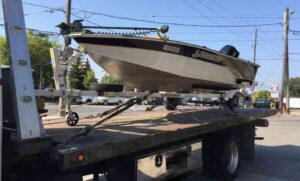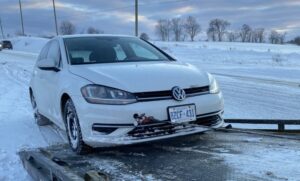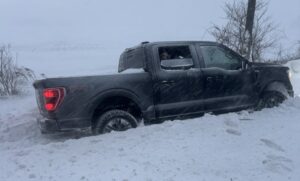For Chevrolet owners navigating the diverse roads of Ontario, from the bustling commutes in Aurora to the serene highways leading to cottage country, encountering a flat Chevy tire can be an unexpected and unwelcome interruption. While modern Chevy vehicles are known for their reliability, tire punctures and blowouts are an unavoidable reality of driving. Knowing how to safely and efficiently change a flat Chevy tire is a crucial skill that empowers you to handle this common roadside emergency, potentially saving you time, stress, and a call for assistance.
At Pars Towing, your trusted partner for roadside emergencies in Aurora and throughout Ontario, we understand that sometimes the safest or most practical solution is to call in the professionals. However, for those prepared to tackle the task themselves, this comprehensive, step-by-step guide will provide you with the specific knowledge and confidence needed to change a flat Chevy tire, ensuring you’re back on the road safely and efficiently.
- Learn More >>>>How to Change a Tire: A Step-by-Step Guide
How To Change A Flat Chevy Tire: A Comprehensive Guide for Ontario Drivers
1. Essential Gear and Safety First: Preparing for a Flat Chevy Tire Change
Before you even think about touching a lug nut, it’s paramount to ensure you have the right tools and, most importantly, prioritize your safety and the safety of those around you. Chevrolet vehicles typically come equipped with the necessary tools, but familiarizing yourself with them beforehand is vital.
1.1. Your Chevy’s Tire Change Kit: What to Look For
Most Chevrolet cars, trucks, and SUVs include a standard tire change kit. Its location can vary:
- Trunk or Cargo Area: Often found beneath the floor mat or under a panel.
- Under the Vehicle: Especially common for older trucks and SUVs, the spare might be mounted underneath the chassis, released by a winch mechanism.
- Side-Mounted: Some vans or older SUVs might have it mounted to the side.
Ensure your kit is complete and in good working order. It should typically include:
- Spare Tire:
- “Donut” Spare (Temporary Use): Most common. These compact spares are smaller than your regular tires and have strict limitations. They are designed for temporary use only at reduced speeds (typically 80 km/h or 50 mph max) and for limited distances (often 80-110 km or 50-70 miles). They are not designed for extended highway travel or heavy loads. Always check the sidewall for specific limitations and pressure (which is usually much higher, e.g., 60 PSI).
- Full-Size Spare: Less common, found in some trucks and larger SUVs, offering full performance.
- Run-Flat Tires: Many newer Chevrolets, particularly performance or luxury trims, may come with run-flat tires, eliminating the need for a spare. These allow you to drive for a limited distance after a puncture. Consult your Chevy’s owner’s manual for specific run-flat capabilities and limitations.
- Tire Repair Kit: Some smaller Chevy models or EVs might only include a compressor and sealant. These are strictly for small punctures and cannot fix sidewall damage or blowouts.
- Jack: To lift your Chevy off the ground. Common types include:
- Scissor Jack: Operated by cranking a handle, lightweight and compact, typically for cars and smaller SUVs.
- Bottle Jack: A hydraulic jack, more robust for trucks and larger SUVs.
- Lug Wrench: To loosen and tighten the lug nuts. This may be an L-shaped, X-shaped (spider wrench), or telescopic wrench.
- Owner’s Manual: CRITICAL! Your Chevy’s owner’s manual contains specific instructions for your model, including exact jack points, lug nut torque specifications, and spare tire limitations. Keep it in your glove box or readily accessible.
- Wheel Chocks (Optional but Recommended): To prevent your Chevy from rolling. If you don’t have dedicated chocks, sturdy blocks of wood or bricks can be used.
- Learn More >>>>Flat Tire Change
1.2. Prioritizing Safety: The Unnegotiable Rules
Changing a flat Chevy tire on the side of the road carries inherent risks. Always follow these safety guidelines:
- Find a Safe, Level Location: As soon as you realize you have a flat, activate your hazard lights and safely pull over to a flat, firm, level surface, well away from moving traffic. Avoid soft shoulders, hills, blind curves, or busy highway lanes if at all possible.
- Engage Parking Brake: Fully engage your Chevrolet’s parking brake. For automatic transmissions, place the shifter in “Park” (P). For manual transmissions, put it in “Reverse” (R) or a low gear.
- Wheel Chocks: If you have them, place wheel chocks behind the wheels diagonally opposite the tire you are changing. For instance, if changing the front-left tire, place chocks behind the rear-right wheel.
- Passengers Out: Have all passengers exit the vehicle and move to a safe location, well away from the road and your working area.
- Visibility: Turn on your hazard warning lights. If it’s dark, use a flashlight or headlamp. Consider wearing a reflective vest or placing safety triangles behind your Chevy to alert other drivers.
2. Step-by-Step: How to Change a Flat Chevy Tire
Once your safety is ensured and tools are ready, you can proceed with changing your flat Chevy tire.
Step 1: Access Your Spare Tire and Tools
- Retrieve your spare tire, jack, and lug wrench from their storage location.
- If your Chevy has hubcaps covering the lug nuts, use the flat end of your lug wrench or a specific tool from your kit (refer to manual) to carefully pry it off. Place the hubcap (and later the lug nuts) in a safe spot where they won’t roll away.
Step 2: Loosen the Lug Nuts (While Your Chevy is Still on the Ground)
This is a critical preliminary step. It’s much safer to loosen lug nuts when the vehicle’s weight is still on the tire, which prevents the wheel from spinning.
- Fit the lug wrench onto one of the lug nuts.
- Turn the wrench counter-clockwise to loosen the lug nut. Chevrolet lug nuts are often very tight from the factory. You may need to use significant force.
- Tip for Tight Nuts: If a lug nut won’t budge, try using your body weight. Stand on the end of the lug wrench handle (carefully, ensuring you don’t slip) and press down, or kneel and use your full body weight. Never jump on the wrench.
- Only loosen them about a quarter to half a turn each. Do NOT remove them completely yet.
- Repeat for all lug nuts.

- Learn More >>>>How do I get a tow truck?
Step 3: Position the Jack and Raise Your Chevy
- Locate the Jack Point: This is extremely important for a Chevy. Consult your owner’s manual to find the exact, reinforced jacking point for your specific Chevrolet model. These are typically small notches or reinforced sections on the frame or pinch welds, located just behind the front wheel or in front of the rear wheel. Using the wrong jack point can cause severe structural damage, bend floor pans, or damage battery packs (in electric Chevys).
- Place the Jack: Position the jack squarely and securely under the designated jack point. Ensure it’s on a firm, flat surface. If the ground is soft (like a dirt shoulder), place a small, sturdy board (if available) underneath the jack for better stability.
- Raise the Vehicle: Slowly raise your Chevy using the jack, turning the crank or pumping the handle.
- Crucial Safety: Continuously monitor the jack’s stability as your Chevy lifts. Watch for any wobbling or shifting.
- Raise the vehicle just enough so that the flat Chevy tire is fully off the ground, with a few inches of clearance to easily slide the spare tire on.
Step 4: Remove the Lug Nuts and Flat Tire
- Once your Chevy is safely raised and stable, you can now fully remove the lug nuts that you previously loosened. Turn them counter-clockwise until they come off completely. Keep them together in a safe place (e.g., in the hubcap or a bag) to prevent them from rolling away.
- Grip the flat Chevy tire firmly, usually at the 3 and 9 o’clock positions. Wiggle it gently if needed, and pull it straight off the wheel studs.
- Place the flat tire on the ground, away from your immediate working area. As an extra safety measure, if space allows, you can slide it under the vehicle’s frame near the jack.
Step 5: Install the Spare Tire
- Carefully lift the spare tire and align it with the wheel studs (the threaded bolts sticking out from the hub).
- Push the spare tire firmly onto the wheel hub until it seats snugly against the braking rotor.
- Hand-tighten all the lug nuts onto the studs. Screw them on as far as you can by hand. Do NOT use the lug wrench to fully tighten them while your Chevy is still elevated; this can cause the vehicle to become unstable on the jack.
Step 6: Lower Your Chevy
- Slowly and carefully lower your Chevy using the jack, allowing the spare tire to make full contact with the ground and bear the vehicle’s full weight.
- Once the weight is completely off the jack, remove the jack entirely and store it.
Step 7: Fully Tighten the Lug Nuts
This is the final and most critical tightening stage for safety.
- Using the lug wrench, tighten each lug nut as much as you can.
- Tighten in a Star or Criss-Cross Pattern: This is paramount for even pressure distribution, which helps seat the wheel properly and prevents it from warping or coming loose. Do not tighten them sequentially in a circle. Tighten one nut, then the one directly opposite it, then the one perpendicular to that, and so on. Repeat this pattern a few times, ensuring each lug nut is very snug.
- Apply significant force, but do not over-tighten (which can strip the studs or damage the wheel). If you have a torque wrench, consult your owner’s manual for the specific torque specification for your Chevy’s lug nuts.
Step 8: Final Checks and Post-Change Procedures
- Gather Tools: Collect all your tools and the flat Chevy tire. Securely store them. If the flat is a full-size tire, it might not fit back in the spare tire well; secure it in your trunk or back seat to prevent it from moving during transit. Reattach any hubcaps.
- Check Spare Tire Pressure (Again): If your spare is a “donut,” reconfirm its recommended high pressure. If low, inflate it at the nearest service station.
- TPMS Reset (If Applicable): If your Chevrolet has a Tire Pressure Monitoring System (TPMS), the warning light might come on or remain on.
- Some GM systems auto-reset after driving a certain distance at a specific speed (e.g., 10-15 minutes above 40 km/h).
- Others might require a manual reset via a button on the dashboard or through the infotainment system (consult your manual).
- If the light persists, a professional service might be needed to recalibrate the sensors.
- Drive Cautiously: Remember the limitations of your spare tire (especially a donut). Drive at reduced speeds, avoid sudden braking or sharp turns, and head directly to a tire repair shop.
- Professional Inspection: Immediately after changing your tire, drive to a reputable tire shop or mechanic (like those Pars Towing recommends or transports to) to have your flat Chevy tire repaired or replaced. Crucially, have the lug nuts on the newly installed spare checked with a torque wrench to ensure they are properly tightened to factory specifications. This “re-torque” after driving a short distance (e.g., 50-100 km) is recommended by manufacturers even after professional installations.
- Learn More >>>>HOW TO JUMP START A NISSAN LEAF

3. When to Call Pars Towing: Your Reliable Partner for a Flat Chevy Tire
Knowing how to change a flat Chevy tire is a valuable skill, but there are numerous situations where calling Pars Towing is the safer, more efficient, and often necessary choice for drivers in Aurora and across Ontario.
- Unsafe Location: If you find yourself with a flat on a busy highway shoulder, a blind curve, an unlit road at night, or any location where changing a tire would put you or your vehicle at risk. Our trained professionals prioritize safety and have the right equipment to work roadside.
- Missing or Damaged Tools: If your Chevy’s jack, lug wrench, or spare tire is missing, damaged, or unusable.
- No Spare Tire (Run-Flat/Repair Kit Failure): Many newer Chevys may not come with a spare, relying on run-flat tires or a tire repair kit. If your run-flat is severely damaged or the repair kit is ineffective for a large puncture or sidewall blowout, you’ll need a tow.
- Seized or Stripped Lug Nuts: If lug nuts are corroded, over-tightened, or stripped, they can be impossible to loosen with standard tools. For a flat Chevy tire in this situation, professional intervention is required.
- Physical Limitations or Discomfort: If you’re not physically able to perform the task, or if you simply don’t feel comfortable changing a tire yourself, especially in adverse conditions.
- Severe Tire/Wheel Damage: If the tire has suffered a major blowout, rim damage, or suspension damage that makes the vehicle unsafe to drive even on a spare.
- Weather Conditions: Changing a tire in heavy rain, snow, ice, or extreme cold can be dangerous, incredibly difficult, and increase the risk of injury.
- Any Doubt or Uncertainty: If you have any hesitation or uncertainty about any step of the process, it’s always best to call a professional. Your safety and your vehicle’s integrity are paramount.
Pars Towing is equipped with the right tools, experienced technicians, and the local knowledge to handle your flat Chevy tire issue or tow your vehicle safely to the nearest repair facility in Aurora or anywhere in Ontario, 24/7. We ensure your safety and the integrity of your vehicle, providing peace of mind when you need it most.
- Learn More >>>>How To Open a Locked Car Door Without a Key
Conclusion
A flat Chevy tire doesn’t have to ruin your day. By understanding the essential tools, meticulously following the step-by-step guide specific to your Chevrolet, and prioritizing safety at every turn, you can confidently navigate this common roadside emergency.








